Blog
Welcome to Amlan’s blog
(A common man’s experience, feeling and more …)
The uniqueness of the spirit of West Bengal with her seven major chakras or energy centres
12 January 2025
If, with fantasy, the geographical or political map of West Bengal is considered as a sketch of a human being, one may imagine the existence of seven major chakras or energy centres stretching from Shri Kapil Muni Ashram, Gangasagar in the south (21.637550 N, 88.075220 E) to Shri Mahakal Temple, Darjeeling (27.047790 N, 88.267910 E) in the north.
Let me present the idea with the following illustrations.
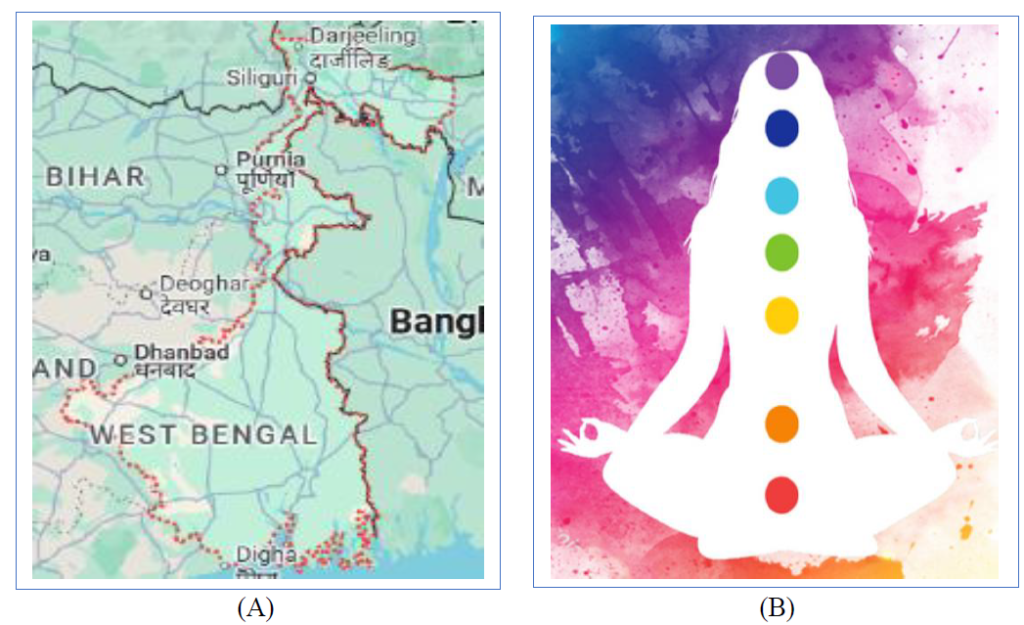
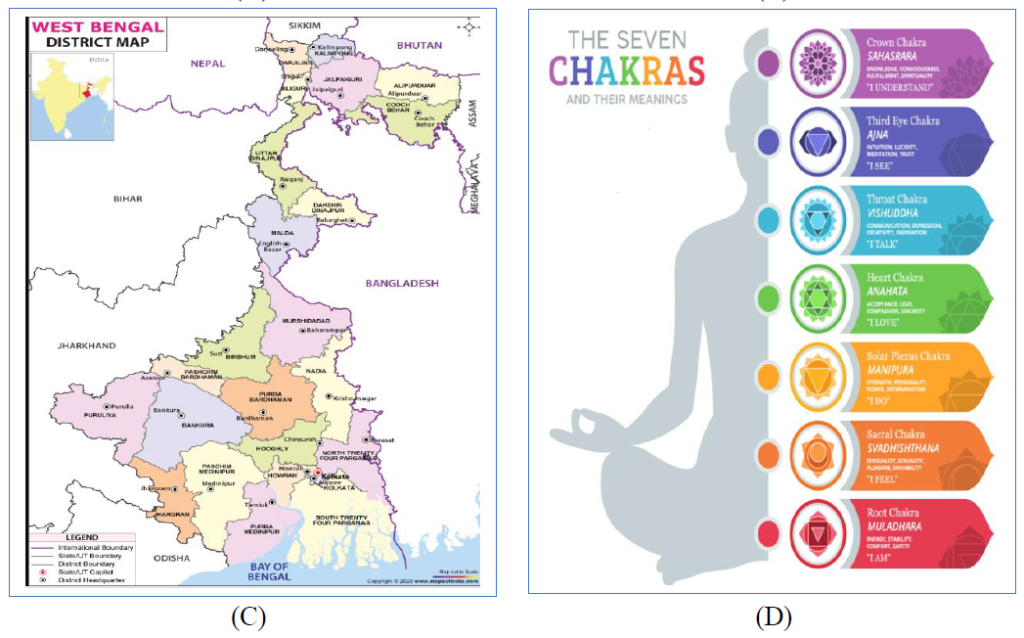
A brief description (with source) of the above illustrations (A to D) is presented below.
(A): Geographical map of West Bengal; Not presented here in scale; [Source: A].
(B): Seven major chakras of a human body [Source: B ].
(C): Political map of West Bengal; Not presented here in scale; [Source: C].
(D): A brief description of seven major chakras [Source: D (after slight modification in the photo frame)]
As the whole humanity is gradually shifting towards the higher level of consciousness, I hope that the basic idea of functioning and importance of seven major chakras in a human body are known to many of us. If someone is unaware of the concept, it is the time to get familiarity with it. The fastest and easiest way is to perform an online search to get some basic ideas about it [1, 2].
We, the resident of West Bengal, with others, know that Kolkata (formerly Calcutta) is not only the political or administrative capital of the State, it is rather more than that. Even if we focus on Kolkata’s common identity, we feel that the so-called ‘power’ or ‘energy’ or whatever affects our practical aspects of life, flows from there (south) to the north (and every other direction) through the invisible spinal cord. Can we imagine that such a fact is analogous to the same of ‘kundalini energy’, which, when awaken, flows from the lower part of a human body (to some, naval region) towards the upper end? Does it mean that Kolkata is closer to both the ‘Root Chakra’ and the ‘Sacral Chakra’ and makes the foundation of the State? If the ‘Kundalini energy’ of West Bengal is to be awakened further for good, it should be done so from Kolkata and the surrounding or parallel regions!
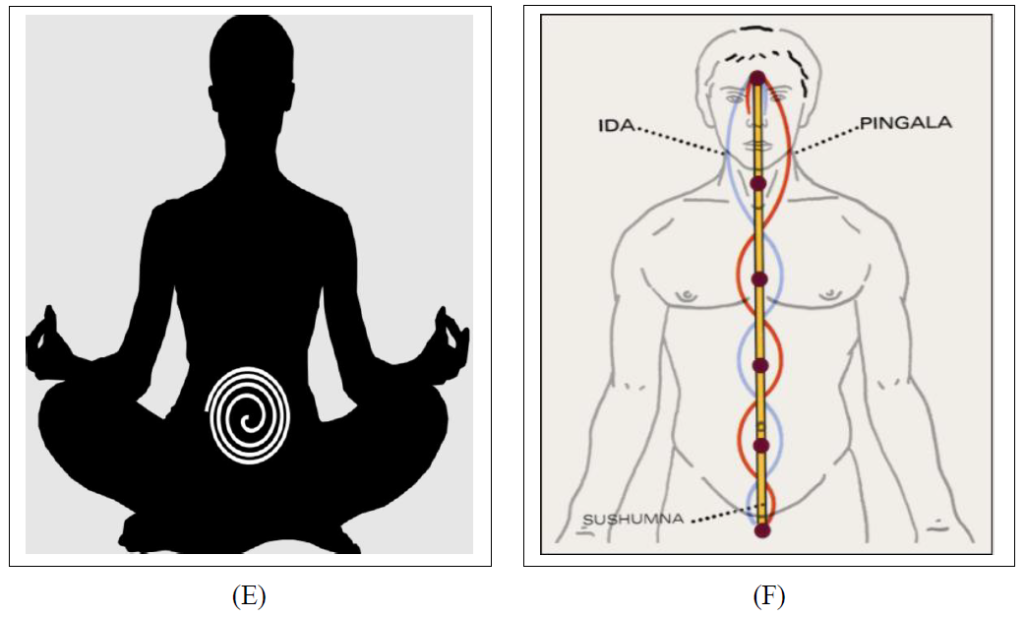
A brief description (with source) of the above illustrations (E & F) is presented below.
(E): Symbol of kundalini energy [Source: E]
(F): Flow of kundalini energy (Source: F]
If we superimpose the map of West Bengal on panel (E), we may imagine that Kolkata and Haora or the adjacent busy regions of West Bengal (including those in undivided Medinipur) fall under the coil, which symbolises the naval region of a human body. It is believed commonly that a massive amount of energy rests in the naval region in sleep mode. That is why we often come across discussions on kundalini awakening. As my objective is to present my idea on the analogy of the existence and functioning of the seven major chakras in human bodies (and that of kundalini energy) with that of the power or energy structures in West Bengal, I am not concentrating on yogic science on the subject matter (also, I am quite ignorant about it). In order to know more about the flow of kundalini energy one may read relevant text (for example, as cited above or else). However, in my feeling, the flow of energy or whatever governs our activities in life in West Bengal may be symbolised by ‘Caduceus’ (when considered as the symbol of kundalini energy).
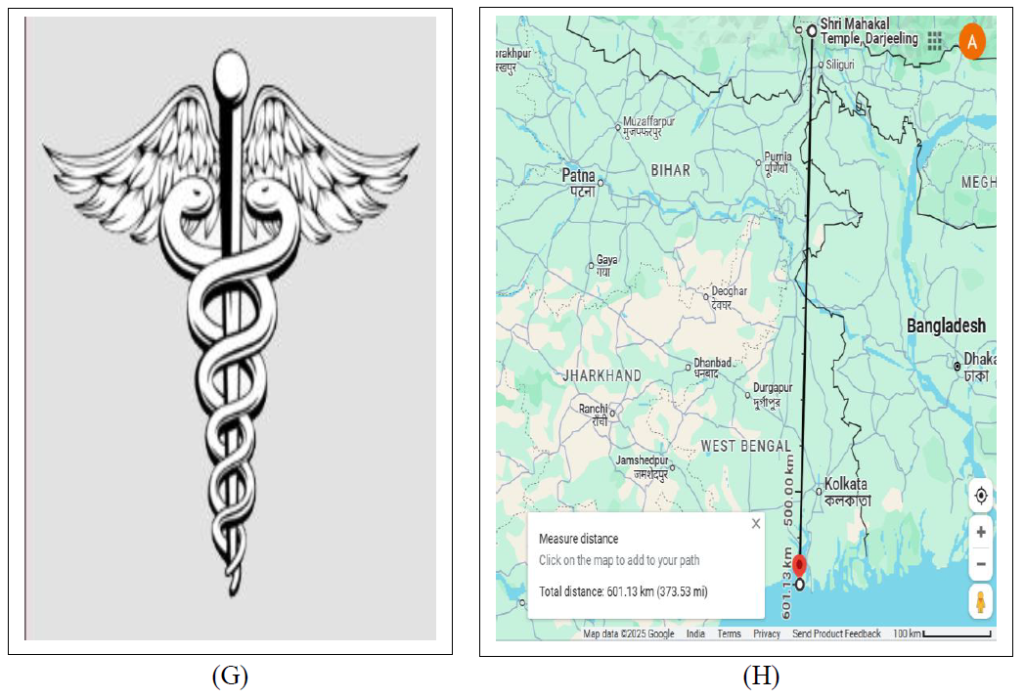
A brief description (with source) of the above illustrations (G & H) is presented below.
(G): Symbolic presentation of kundalini energy [Source: G]
(H): Location of the two major chakras in West Bengal [Source of the map: H]
I have used the term lower and upper in regard to the location of the seven major energy centres without any hierarchy. For example, one cannot compare the importance of a roof (as the Crown Chakra) with that of the foundation (as the Root Chakra) in case of a house, as the both are important [3] . Also, I have taken names of some places of interest from the point of view of spirituality without attaching any cultural or religious value to them. To me, all places are equally important. Also, the vibes all the chakras equally (or equitably!) touch all beings. The vertical line (as a spinal cord) in panel (H) is invisible and may be non-linear in reality. At the beginning, I said that (considering the parallel adjacent districts or regions of West Bengal along the same latitude etc.) Kolkata is not only Kolkata to us, it is more than that. Similarly, I may say that each of the seven major strata (regions covering all the districts of West Bengal horizontally) associated with the respective chakra is more important than what we usually feel in everyday life. For example, one may notice that most of the Indian stalwarts, who had origin in Kolkata or elsewhere, spent considerable time in Darjeeling Hills for their research, writing or work. The common visitors in Darjeeling do not come only to enjoy its scenic beauty. To me, such common visitors are not common ones. What I feel that, when the vibes of the individual ‘Third Eye Chakra’ match with those of the place, people resonate and act.
I am not commenting on specific locations of the remaining five chakras within West Bengal. I hope that my readers will do it. I would like to share that the idea under discussion came in my mind when I visited the Chataidhura Shiv Mandir in Darjeeling (27.006270 N, 88.210610 E; distance from Shri Kapil Muni Ashram: 597.13 kms) during the Maha Shivaratri of 8-9 March 2024. And instantly, at that time, I felt a strong desire to visit Shri Kapil Muni Ashram in Gangasagar. On the eve of Makar Sankranti 2025, let me conclude today by saying that if the desired energy flows in a desired manner, all the energy centres (seven major chakras) in West Bengal will remain activated and the uniqueness in her spirit will vibrate further for a better common future within the Country and beyond.
A pdf version of the above writeup is available here.
I announce the passing of my father, Shri Ram Nath Majumder
11 January 2025
My father passes away on Thursday evening (9th January around 8.40 pm IST) at age 84.
He was suffering from ageing related issues since Covid-19 pandemic period, although he was not too aged (84 years only).
On 2nd January 2025, in the morning, he was admitted to a private hospital in Cooch Behar with breathing problem. He was diagnosed with ‘Double Pneumonia’. We were told that, in such a case, chances of survival are very less for people aged 65 and above. He left ultimately after a rigorous suffering from the disease as well as with a lot of pain from the so-called modern treatment.
We need to follow some rituals for 11 days leading to a ceremonial prayer – Upasana (on 10.30 am) for his eternal peace, and a social gathering (from 1 pm onwards) on 19th January 2025 (Sunday) in commemoration of his presence in our lives.
Aum shanti … aum shanti … aum shanti.
Unconditional love and respect for others: a jargon with the idea of staying healthy and happy and some scattered thoughts
21 April 2024
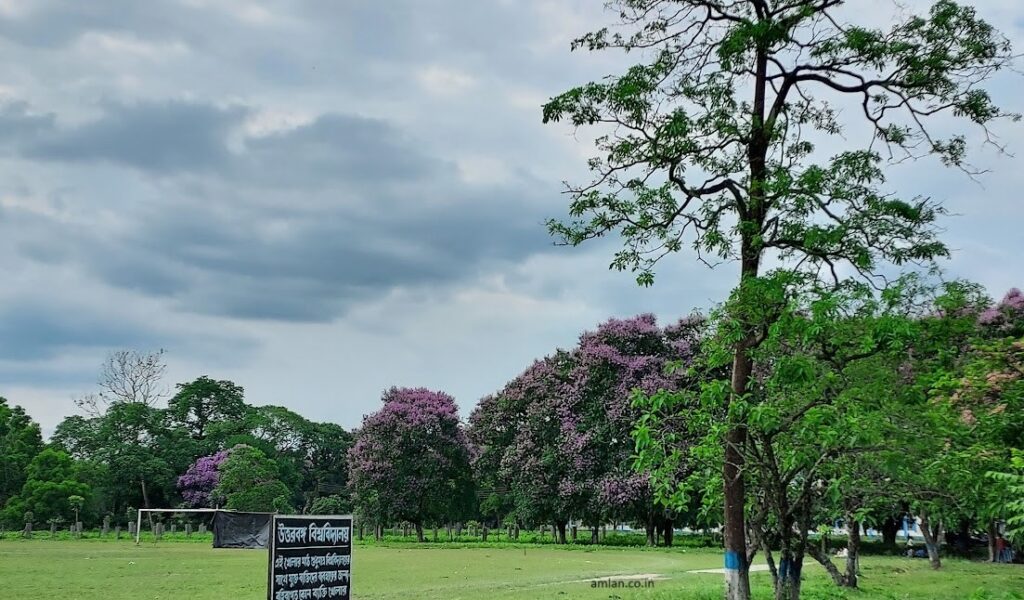
Can we say that unconditional love and respect for others are the keys to stay healthy and happy? The answers are: yes and no. ‘Yes’ for those who love and respect others unconditionally – without any expectation of gain or benefit from somewhere at the end. Such an idea is also echoed from: कर्मण्येवाधिकारस्ते मा फलेषु कदाचन – You have the right to perform your actions, but you are not entitled to the fruits of your actions[1]. Although, the principle was prescribed in times of war, we may follow it in some way or other in times of peace too. If love and respect for others together is an action (which is not prescribed of course, which comes out from deep within), one should not look towards the fruit of it at the end. So, why not ‘love and respect for others’ go without any purpose? ‘No’ is for the case, when our ‘unconditional love…’ becomes conditional – a condition to keep ourselves happy and healthy. We have to remove the term ‘unconditional’ from what we have said. We are selfish! We love others to reap benefit!
Even if the subject is ‘health and happiness’, we are not be selfish for that. I beg to be excused that I will cite examples in favour of my arguments from everyday experiences, old scriptures or else, which will suit enough to go with the spirit of this writing. However, please interpret those in essence of this writing, as chances of misinterpretation always remain. In regard to our subject of discussion, we know that Lord Shiva consumed poison, to save others. Although, he did not shallow it completely – he held it inside his throat. Was this action of consuming poison for the benefit of others good? I have seen many open-hearted persons around us, who take poison knowingly – either in the form of ‘smoke’ or ‘drink’. I have used the term ‘poison’, in the sense that Excise Directorate of our State/Country gives statutory warnings in regard to use of such items – that consumption of such items may cause cancer or else. I have seen many persons in my journey of life as well, who are always busy in search of the ‘amrita’ (nectar) or the ‘cream’ to grab and consume it. Is such a behaviour good? I am asking this question even though we all know that consumption of ‘amrita’ is not likely to put someone’s health at risk.
For the sake of simplicity, if we assume that bad things (such as poisonous commodities) are comparatively abundant than good commodities (such as ‘amrita’) in these days in our part of the World, the first group is doing good. They are reducing the stock of ‘bad’ by consuming it and consequently mitigating its possible impact on potential others, who might consume it subject to its availability. If the number of persons in the first group is comparatively higher, because of higher demand for bad (subject to supply constraint), price of it will be skyrocketing. This may also restrain others to consume it. On the other hand, as good commodities like ‘amrita’ are scarce, the second group is doing bad by reducing the stock of it through consumption and denying potential others, who might consume it. ‘Amrita’ will become almost non-existent and priceless and common people will lose control over it. It is easy for us to derive logically, from the perspective of common mass, that the behaviour of the people in the second group is not desirable. And this conclusion resonates with my inner vibes too. I have experienced that comparatively, people in the first group are more helpful to others. They have good mental health. In times of common or societal action (with sacrifice of time and resources for the benefit of others), they are likely to stay on the forefront. They are certainly contributing to social health. They are comparatively less selfish, rather more altruistic.
I would like to share one old story in this regard with you all. It is an imaginary story. It refers to a period when common human beings did not exist on Earth. The first human being, ‘Prajapati’ existed only. The space was full of good and bad spirits. The story came to be known as the “Prajapati Test” – a narrative from the great writings of Veda, called Shatapatha Brahmana. The story in brief, as portrayed (in the present form) by Marcel Henaff[2], is presented below:
- The first human being on Earth, Prajapati was unable to draw a distinction among the various spirits he saw in the universe and to separate demons from the Gods.
- Therefore, he offered them a feast of rich food.
- Some started eating for themselves with gluttony and voracity.
- Others did something quite different. They took the food with their hands and presented it to each other’s mouth.
- Prajapati then understood that the latter were Gods and were the ones that humans must admire and imitate.
From the above story, it is easily understood that the latter group performed a zero-gain operation. Instead of taking food by herself / himself directly, s/he offered food to the person sitting opposite to her/him. The person on the other side, also reciprocated the same. By doing so, none of them gained materially. Why they behaved so?
If we observe this behaviour with the eyes of the supporters of rational choice theory, the demons are more rational and Gods are stupid. In its simplest form to state, in economics, rational choice theory assumes that individuals make consumption choices so as to maximise their happiness, satisfaction or utility[3]. In terms of the basic tenets of this theory, the first group in this story as well as the second group of people in my example, as discussed above (who are always in search of the amrita’ or the cream) are right in their behaviour.
In another view:
(a) the Gods affirm and confirm the fact that they exist for each other, and
(b) they want to express through the food that they eat the necessity with pleasure of being together, of being an organic and coherent group.
It is needless to say that they have unconditional love and respect for each other. Their action was not at all related to any material gain. This is how and why we can be altruistic and move away from selfishness to reciprocal recognition to each other and live in a healthy and happy society.
As above, we came across two groups of spirits (not human beings) with two distinctive features: love and respect to self, and love and respect to others. Human beings are to decide about which one to adopt. Depending upon the circumstances, a person may go for a combination of the both in reality. Ultimately, if the latter overweigh the former, one may expect a healthy and happy society.
World Health Organisation defined health[4] as: “… a state of complete physical, mental and social well-being and not merely the absence of disease or infirmity”. If this is the definition of health, then we need to consider well-being in all the three dimensions together: physical, mental and social. I am worried about the first group of people in my first example (who are likely to be altruistic). They are well runner in the dimension of mental and social health. Well-being in the physical dimension is lagging behind for putting (physical) health at risk by taking poison and ignoring the statutory warning on harmful impact of smoking and drinking. Is desire for good health is an indication of selfishness? The answers are: yes and no. ‘Yes’ is for the situation, where health is considered as an output. ‘No’ is for the instance, when health is thought as an input.
In order to understand the point, we need to divide the humanity into two groups (in line with the above thought) with respect to the nature of service with which people are mainly engaged with: ‘service to self’ and ‘service to others’. Obviously, those who consume for themselves only, health is an output to them. Selfishness is associated with it. Those who are in service to others, health is an input to them. In order to serve better and to sustain it for longer, one needs to maintain good health. Please let me give one more example from my experience to understand the situations when health can be considered as an input or an output respectively. I beg to be excused again as I am highlighting my personal lifestyle, or more particularly, my food habit. I have become a vegetarian for more than a decade ago. Imagine my condition please – being a Bengali – living in the heaven of fish and meat eaters – ignoring the delicious bakery products (which mostly use eggs) – I became vegetarian. Now, every time I join a social gathering for feast (say, in a marriage ceremony), I need to answer lot of queries raised by the hosts or others. The questions are almost similar: am I under the treatment of any doctor or whether I am suffering from any disease or whether I have been advised by any ‘Guru’ to become vegetarian and so on. My simple response is ‘no’. I make them clear that I did not receive any advice from any doctor or any ‘Guru’ to become vegetarian. Often, I just lough. At times, some people ask me more specifically – don’t you like chicken or goat meat? Gently, I reply that I like to see them playing on the ground! How could I say that I am worried about their health and well-being too[5]. I silently speak to myself that I am not that much selfish to give up eating chicken or meat to become bodily or physically healthy. If I would do so, I am nothing but a shellfish person!
However, I never insist or influence any person to imitate me. I never disrespects the food that I do not take. I have equal respect for the food that I take and for those, which I do not take. I never say that I do not take ‘food A’, as it causes this or that. Simply, I do not take it. In order to avoid any debate, often I say that there is no purpose behind my vegetarianism. Also, as I admit that diversity enhances the potentialities of survival, I respect all cultures, all lifeforms and beliefs. Rather, it is better to say that I do value judgement without attaching any value to any subject. I am not a reductionist. Reductionism[6] is a body of thought, which reduces the capacity of human beings to evaluate others or other ways of knowing something.
Another aspect that I would like to discuss is that individual actions or behaviour are specific to time and space in reality. They change over time and space (context etc.). We need to interpret those accordingly. I have one ready example with me, which will clearly show when health is an input and when output also. However, from this example, we cannot relate individual behaviour with ego or selfishness or else. It is a light example or observation and I laughed a lot while writing it. I went to an ophthalmic clinic cum spectacle shop for testing of eyesight and have new glasses. It was at the evening and I had to wait for an hour or so. What I have observed that one College student (as I guessed) took nearly one hour to search the most suitable spectacle frame with repeated trials to understand which one will match the best with face. I understood that health (related to wearing of specs) is an output for the student. The student may go to College with new look and have some photos, which may further be posted in social media or else. It took nearly five minutes for me to choose one frame. For me it is an input. My priority was to focus on the use of it to read and write, and to delivering my services. So, my output was my service – using the specs as one input. If the student works with the mass media or mass communication, in that occasion, health is both input and output. Also, in the ‘long run’, the student may behave differently.
With this example, what I would like to say that we should not judge one person from one observation (about her/his action or behaviour). We need to have patience and wait to observe again if there is any reptation in the action or behaviour. If we point out a dot on a black board, we may draw as many as straight lines through it. Similarly, from one observation, we cannot conclude clearly – it may be good or bad or else. In order to draw one straight line, we need two points. One line only can be drawn connecting the two points. So, at least two observations are needed to make an assumption (hypothesis) about an action performed by a person. If it is followed that the actions or behaviour (imagined as dots) in the third, fourth, fifth observations and so on (depending upon the time and context), fall on the same straight line (or remain in the close proximity of it), then only we can draw a straight forward conclusion. Although, it may not be time-tested. We know that if a coin is tossed, the probability of getting a head or tail is half. In reality, we may do it say, for three times, and we may get head only in all trials. Can we say that the probability of getting a head is one? No. When we toss a coin innumerable time, then only chance of getting a head and tail becomes equal, i.e., half. So, patience is another important aspect, which one should remember. It takes time and multiple processes of purification to make one impure pure. We should not take any harsh decision from any single observation of action or behaviour of any of our members in the family or society.
To conclude, let me share one lesson (if I recall it correctly), which I read during my school days[7]: “স্বার্থ বুদ্ধিটি ত্যাগ করিলে একান্ত নিজ প্রয়োজনে সংগঠিত সেবাও দেব-সেবায় পরিণত হয় |” It means that if selfishness is given up, ‘service to self’ also becomes ‘service to God’. Service to God is nothing but service to humanity. To me, God is nothing but an ocean (or space) of energy. And we all are floating in the same and bumping according to its vibes. We need to align our body-mind-spirit with those vibes for smooth sailing. We cannot escape alone, as we are connected by an umbilical cord with our friends – family – society. If the cord is torn, we will get lost as a kite does, when its thread is disconnected. With this sense of wisdom, let us make an appeal to each other so that we may keep ourselves healthy and happy in all dimensions of life with unconditional love and respect for everyone.
[1] https://www.holy-bhagavad-gita.org/chapter/2/verse/47.
[2] Henaff, Marcel. (2009). “The Prajapati test: response to Amartya Sen”, in Against Injustice, Gotoh, Reiko and Paul Dumouchel (Eds.), Cambridge University Press, New York, pp. 66-70.
[3] https://en.wikipedia.org/wiki/Rational_choice_theory.
[4] https://www.who.int/about/accountability/governance/constitution.
[5] https://amlan.co.in/wp-content/uploads/2018/04/Amlan-Paper-Wellbeing-Nonhuman-Beings.pdf.
[6] Shiva, Vandana. (1988). Staying Alive: Women, Ecology and Development, Zed Books, London, p. 21.
[7] In books given by my parents for character building, which were authored by their Gurudeva. A short glimpse of the philosophy of this great person was presented by Dr. Virginia Moore, which is available at (under the heading ‘Dr. Moore Meets the Yogi’): https://scottsvillemuseum.com/portraits/homeJM01cdJM01.html.
The above writeup was published in the magazine “NBU Carpe Diem Vol. 1 No. 2 April 2024” (pp. 50-54), which is avail in pdf here.
A memorable trip to Chataidhura – an offbeat destination in Darjeeling on the occasion of Maha Shivaratri 2024
10 March 2024
I went to Chataidhura (6,956 ft.) – a hilly village in Ghoom Pahar Forest area of Darjeeling on 7th March 2024 to observe Maha Shivaratri of 8-9 March 2024. There is a temple of Lord Shiva in that village. As winter left Siliguri (and the plain areas of Darjeeling district) in the end of February, I took one light woollen sweater only in the trip. I though there won’t be much cold in Darjeeling hills these days. I reached Ghoom at around 7 at the evening. I was waiting for public transport service (shared vehicle) to reach the village, which located around 4.5 kms away from Ghoom towards left. It was terribly cold and the area was covered by clouds or mist. There were no public vehicles. One family was returning from Darjeeling town to Sukhia Pokhari with their private vehicle. They took me in their vehicle. They said that they recognised me as outsider and as vehicles under public transport do not run in that route at evening, they decided to help me.
I reached the village with them. But it was fully covered by cloud and terribly cold. There were not phone networks at that time. I could not contact homestay manager. Then the gentleman with me started shouting with the name of the homestay. One lady came out from her home in dark and assisted me (even carried my language) to reach the destination! I offered some money to the gentleman, but he refused to accept it. So, it was one hitchhiking for me!
Homestay manager took me to the nearby Shiva temple – preparation was going on. It was just a stone’s throw from the homestay. Also, I was taken to the kitchen of the temple, where four persons were actively involved in making ‘sel roti’ as prasadam for the visitors on 8th March. Shiva stutis were being played in loud speakers. The ambience was excellent.
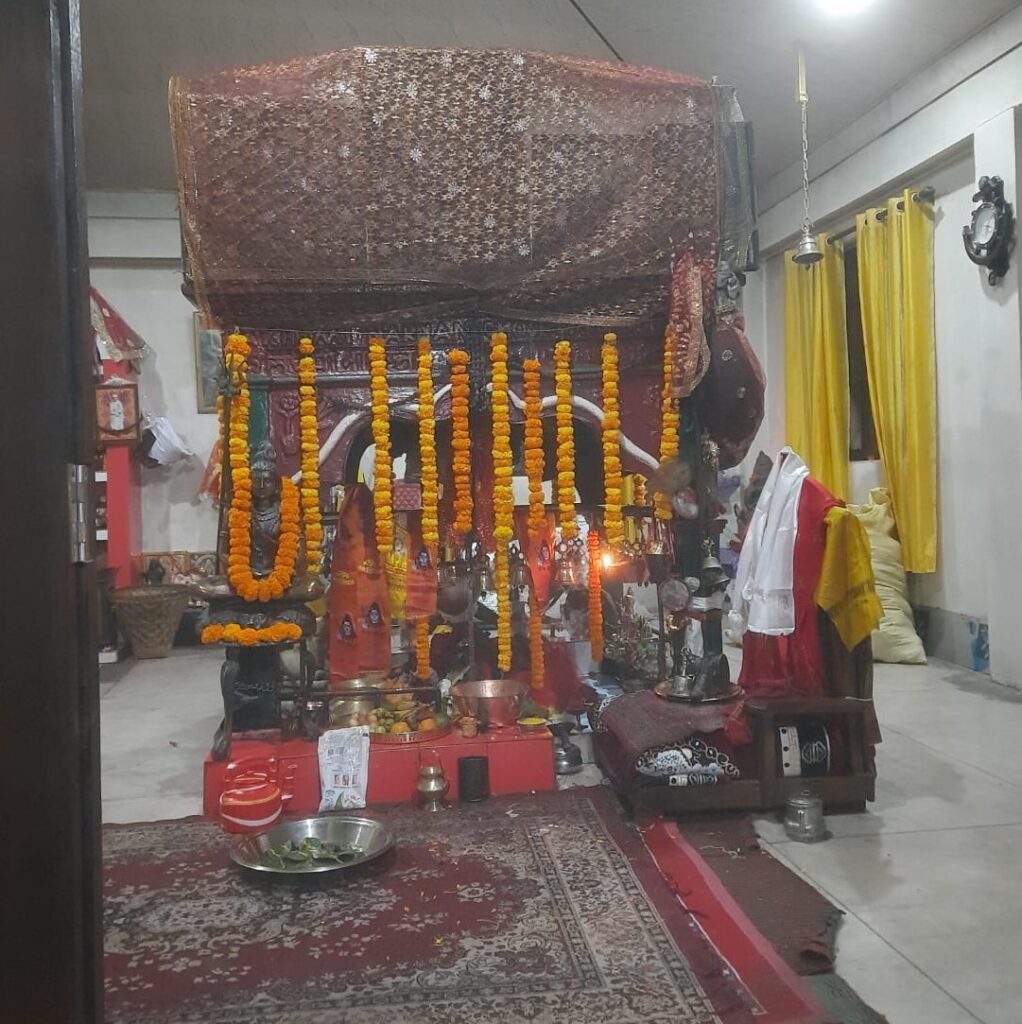
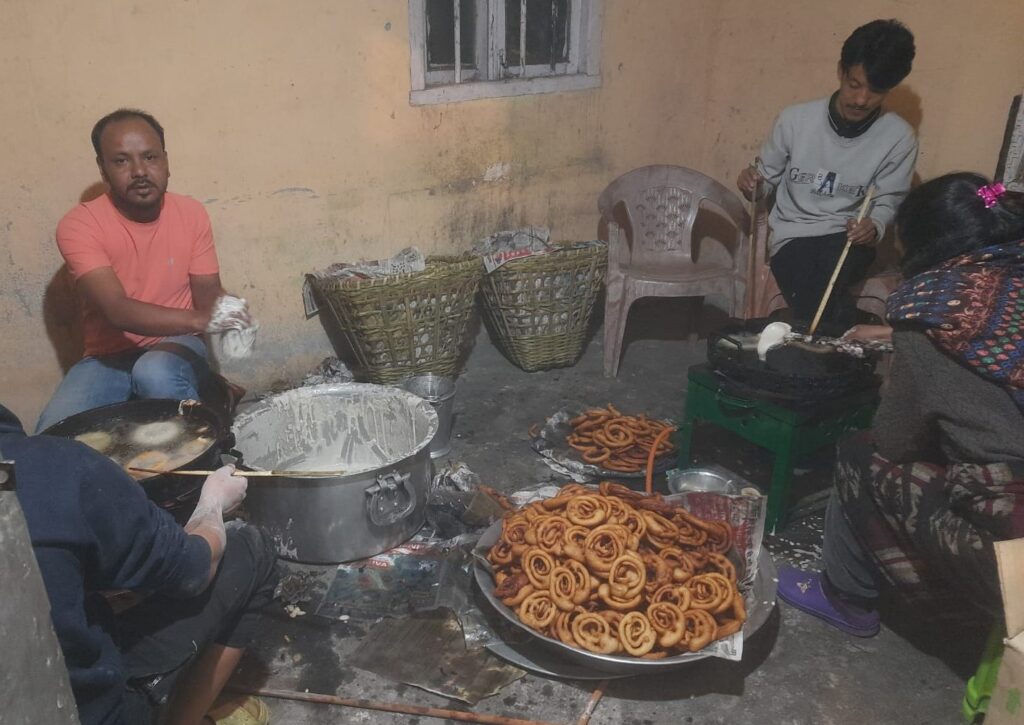
I came back to my room in the homestay and did dinner with some fruits, soaked kabuli chana and ground nut and roti-sabji, which I carried with me from home. Nowadays, I take food twice only. Once in the morning – in between 9-10 am, and for the second time, in between 8-9 at evening. The menu is similar – in the morning in place of roti, just a cup of cooked rice. Also, at home, with these, I take dal (liquid dal or dal vada) and milk twice. For the rest of the day and/or night, I breath air and drink water, as required (with the exception of some herbs and one prescribed drug and a cup of black tea with two crackers in the morning). I am fine. I am well aware that solar flare is going on with its peak in mid-2024. On the spiritual side, I hope that my present lifestyle will help me to align my body-mind-spirit with the extra energy that is coming down from the Sun.
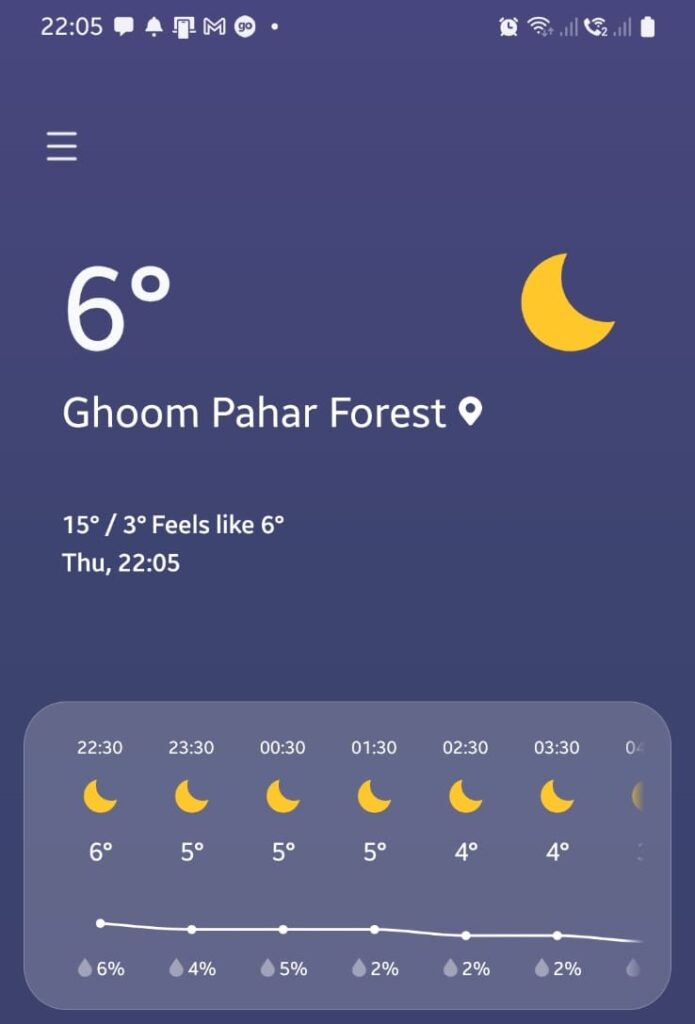
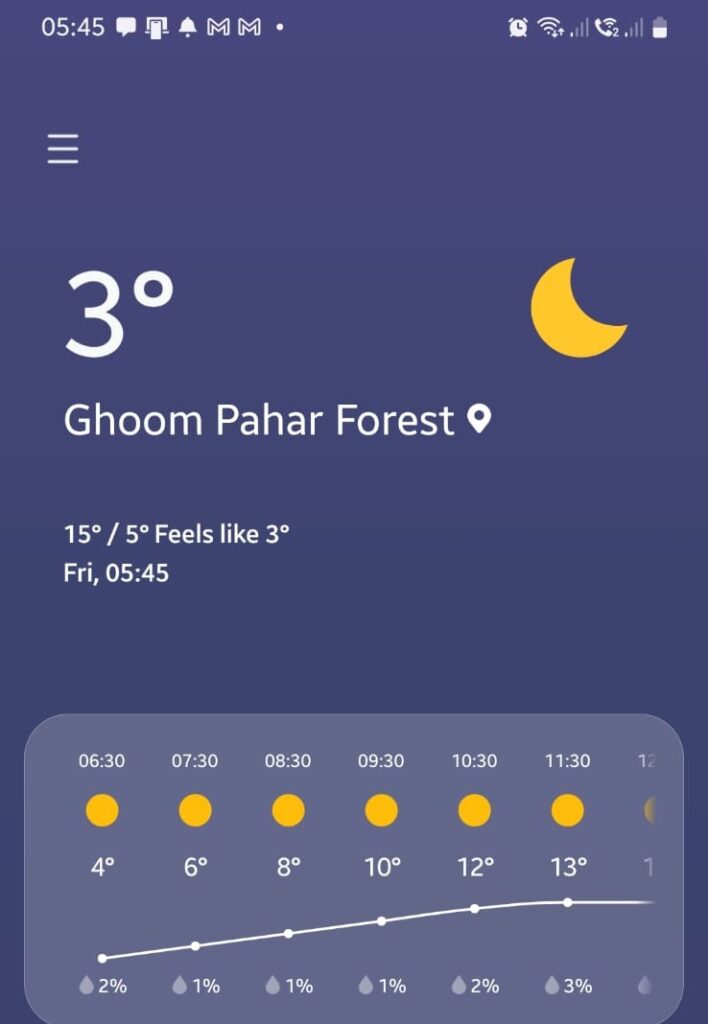
The only problem at Chataidhura was that of temperature, which was coming down gradually at evening. I was not well prepared with heavy winter cloths. At around 10 pm, I took a screenshot of my mobile phone, which was showing a temperature of 6 degree Celsius. I woke up at 5.45 am and took screenshot again. It was 3 degree Celsius at that time and the same continued till 6.15 am.
After taking bath, I visited the temple for my rituals at 7.30 am. In true sense, I did not perform any usual rituals. I enter into the temple complex with a small pack of incense sticks. I ignited the sticks, offered my pronam to Lord Shiva and put those sticks in a pot outside the temple. The priest was playing damaru and reciting mantra at times. On the North-Western side of the temple hall, one lady-priest, was playing damaru in one hand and a ghanta in the other and reciting Tara Mantra (as I guessed) in Tibetan style probably. I enjoyed everything. I stayed there till 10.15 am. In between I took my food (as I brought) and a cup of milk (provided by the homestay). With time, visitors started coming. Gradually, the temple complex became crowded. Hot milk-tea was being served on the road – in front of the entrance of the temple (I did not take). There were enough seating arrangements. In between 9-9.30 am, a group of people (came from outside the village) chanted some portions from Shiva Purana (or Veda) with Vedic accent. It was mind-blowing! Maha Mrityunjay Mantra and Shiva stutis were being played in loud speakers for rest of the time. My heart was full of joy. I felt that the bliss I sought from this visit, was obtained. Also, it was not possible for me to tolerate the cold. I thought the situation will change gradually. But it was windy and cloudy. Day temperature increased to 8 degree Celsius only at around 10 am.
By that time, sel roti and aloo dum were being served as prasadam. My host lady was engaged in that with others. It was a very well-organised event. Also, the village is very neat and clean. I took my tiffin box and took some sel rotis (not aloo dum) for home and conveyed her that I would like to leave. I checked out by 10.30 am and left the village. I returned home using public transport services by 1.30 pm on 8th March with the intention of observing rest of the Maha Shivaratri 2024 at home only. The trip will be memorable for me for ever!
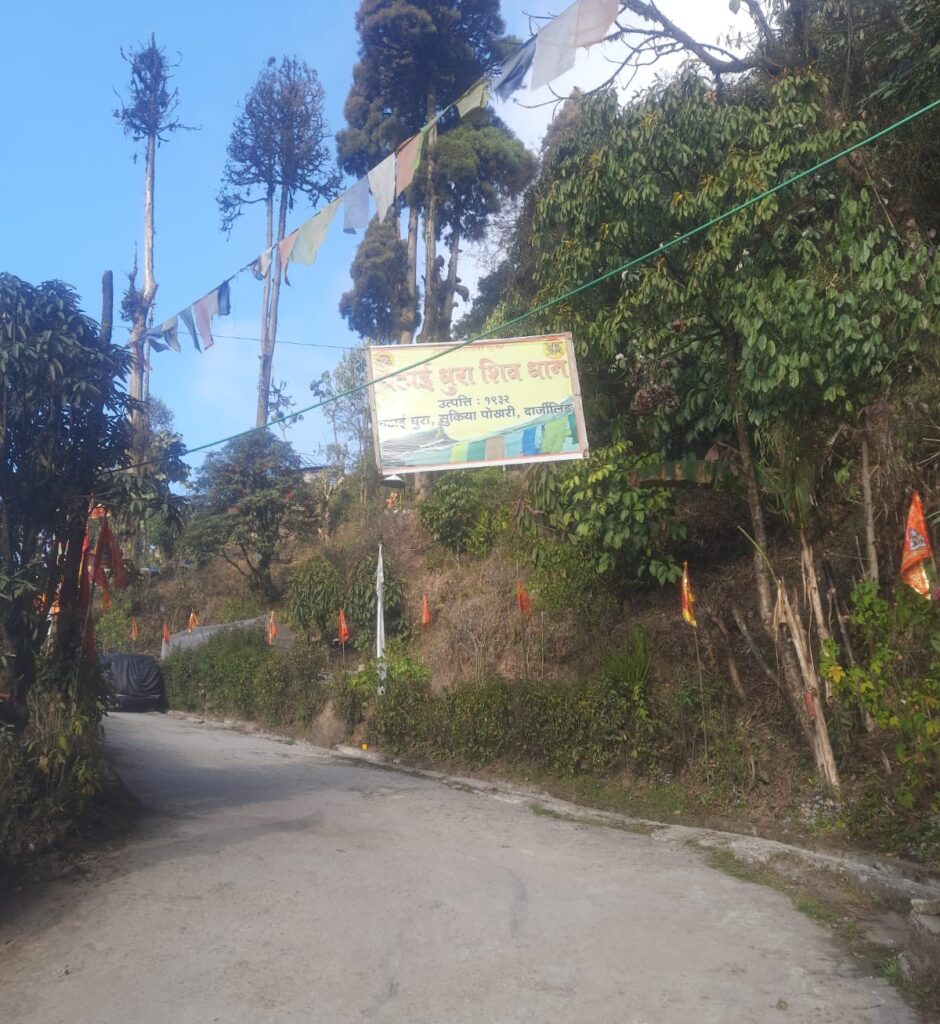
A pdf version of the write up is available here.
My thankfulness to Prof. Om Prakash Mishra and others
(On completion of my first phase of administrative experience: 21 March 2023 – 20 May 2023)
20 May 2023
With some unpleasant feelings, Oscar Wilde once wrote that “Something was dead in each of us, and what was dead was hope”. Although, we have a different context and had a different situation in recent past, in a way or other, the above quote is equally relevant for us, as due to the different happenings and consequent collages in our inner and outer realms, we were losing hope gradually. Keeping our soft feelings away and being practical, if we look at our work, I would rather say that we were approaching towards a ‘void’ situation, as several crucial administrative positions remained vacant posing obstacles to run even regular and essential activities. All of a sudden, Sir was sent to lead us, and who ignited our ‘hope’ instantly. Staff members – from juniors to those at the middle, like me, and seniors – or stakeholders with small and trivial roles or of consequential importance, resonated with the vibe that poised around us with his presence. I hope that such vibration and the ‘big push’ will continue to sketch the trajectory of our common goals and those of the society at large in reality. I am thankful to you Sir, unexpectedly, for giving me an opportunity to serve in administrative capacity, in addition to my normal teaching and academic activities. I am thankful to my students, who, acknowledging my busy schedule, are having sessions in odd hours – in the early morning or evening. I am thankful to my colleagues (including all in my usual and new establishments), all the stakeholders and my friends with the print and visual media for their constant encouragement and support in all possible ways. However, please do not forget to judge me, in principle, on the question – whether, in rendering service, I am enabling light to touch everyone without refraction!
In love and service,
amlan.
News headline (1): Available here.
News headline (2): Available here.
The silent postures of the Himalayan Sector of the University of North Bengal, Darjeeling
20 May 2020
The area, within the main campus of the University of North Bengal, where we live in, is popularly known as the Himalayan Sector. It is located in the furthest (North-Western) corner of the campus … and far from the madding crowd. The view of ‘The Himalayas’ is so clear from this area throughout the year, except for the cloudy and foggy days. The golden necklace (of lights) sparks from the dusk around the Kurseong region of the mountain almost every day. Probably, for this reason the area is named so – the Himalayan Sector. Officially (as per the University classification), it is known as the Western Sector. The residential areas are located in the Eastern and Western sides of the campus respectively. We live in the northern part of the Western Sector.
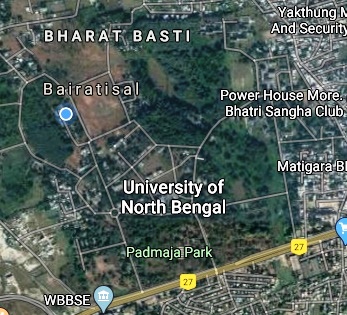
Except some noises in the airspace and some loud utterings from the playground in the early morning and late afternoon, and the same from some other regular activities, the place is more than calm and quite throughout the day and night. Of course, I consider the chirping or shrieking or hooting of insects and night birds from dusk over and over as a part of silence! Strangers with genuine need only come here – such as delivery boys, hawkers with fruits and vegetables, fish etc. Unnecessary loitering is rarely seen. People of the adjacent area, who use the kutcha road (like an embankment) that stretches between the playground and the residential complexes of the Himalayan Sector, go silently. Also, young and aged persons are seen to spend their silent moments here on this road in the morning as well as in the late afternoon. Some regular activities, which became part and parcel of our daily life, such as the regular patrolling of the Watch and Ward Department – an essential service from the University, and use of vehicles by us, break the silence in day and at night to some extent. The mobile telephone network is poor and often we speak louder than usual breaking the silence. However, in my overall assessment, the Himalayan Sector is a zone that thrills in silence. Can you imagine such a silent zone in an urban world?
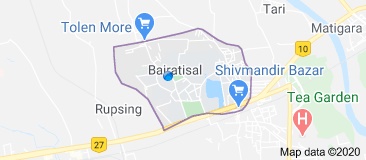
According to the Indian Census 2011, the area belongs to Bairatisal (CT). CT stands for Census Town implying an urban area. Although it seems like a village, it is not conceptually. One may Google or check at Wiki or look at the Census India 2011 document on definition and concepts of a CT.
In India, a census town is one which is not statutorily notified and administered as a town, but nevertheless whose population has attained urban characteristics as listed below:
(a) Population exceeds 5,000; (b) At least 75% of main male working population is employed outside the agricultural sector; and (c) Minimum population density of 400 persons per sq. km.
As the population of Bairatisal is approximately 5000, it is classified as Class-V Census Town. According to University website, the main campus is spread over an area of 330 acres (1.3 sq. kms) and lies between Siliguri and Bagdogra Airport, in the Terai region. As per census documents, the area of Bairatisal is 2.51 sq. kms. Almost the whole of the main campus, except some portion of Padmaja Park, Gate No. 1 and Gate No. 2, belongs to Bairatisal. The Law Department of the Campus (including the above-mentioned exceptions), on the other side, belongs to another Census Town, namely Bara Mohansingh. However, if we divide the Bairatisal into four quadrants, surely the Himalayan Sector falls in the fourth quadrant, i.e., the North-Western one.
The beauty and overall appeal of the nature of this place generate some sort of an inarticulate feeling, which is not easy for me to write. Once, I wrote somewhere that … “It is not always possible to document everything in the same language. Sometimes it is easy to write something than displaying. Sometimes … the opposite.” In line with the same, I have the only option here to display the glimpses of the subject matter to document my inarticulate feeling on the same! I hope that you will understand and enjoy.
Also, please allow me to add more glimpses continuously, as the nature reacts differently in different seasons. For example, the flowering Palash trees – The Trees of the Flame – convey the onset of Spring. The grounds also remain full with the orange-vermillion flowers. While returning from the Department, I often take the narrow path from the NBU Faculty Club, keeping the Sal Kunja (the forest of Sal trees) on the right, towards the multipurpose playground. On the way, often I collect some Palash flowers from the ground for home – in remembrance of one unusual event that I did 25 years ago. When I was a Part II student in 1995, I climbed one Palash tree to pluck some flowers in response to a request from my friends just before the day of Saraswati Puja. Now, on the onset of Summer, the whole area is blooming with the flowering Jarul trees – The Queen’s Crape Myrtle.
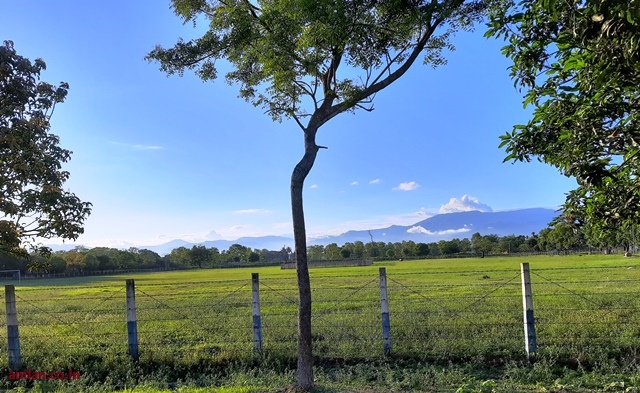
[Photography: Brinda Majumder]
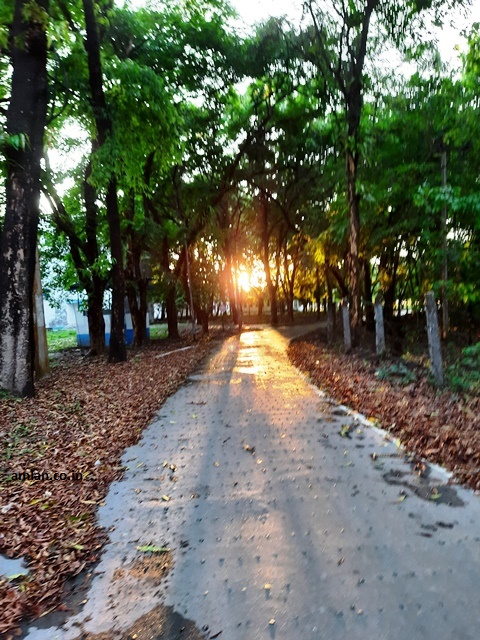
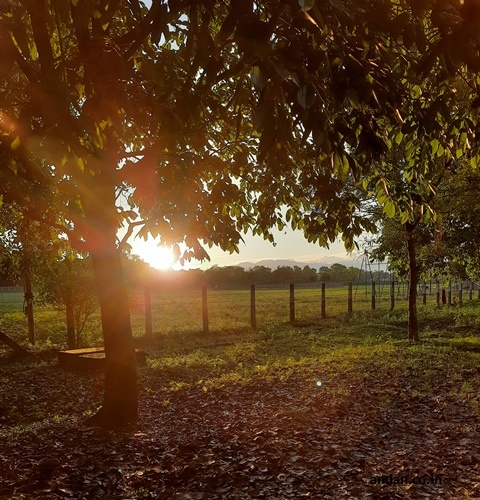
[Photography: Brinda Majumder]
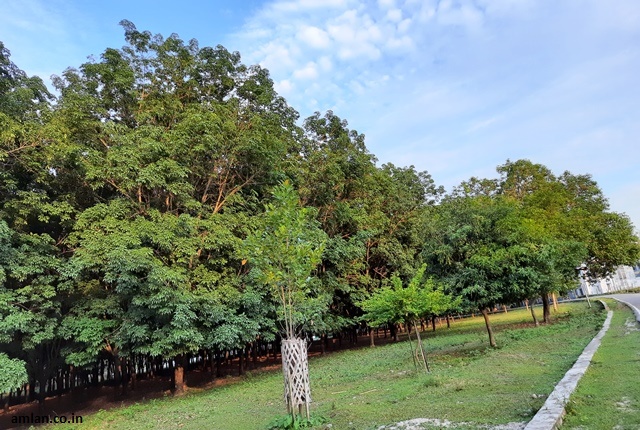
[Photography: Brinda Majumder]
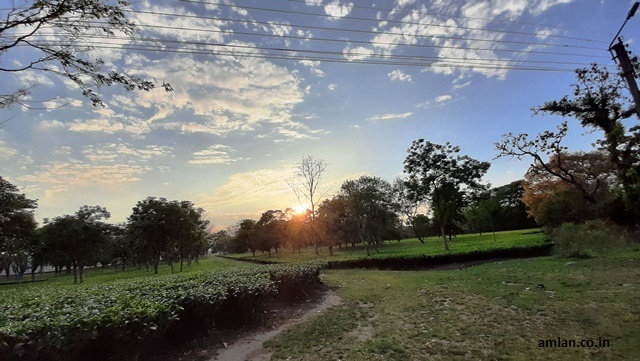
[Photography: Brinda Majumder]
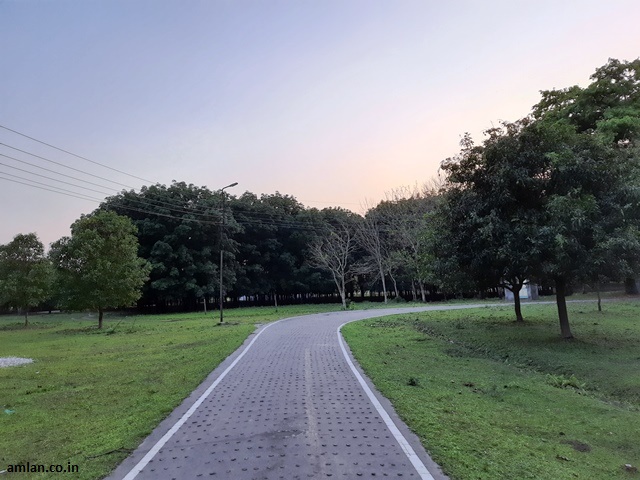
[Photography: Brinda Majumder]
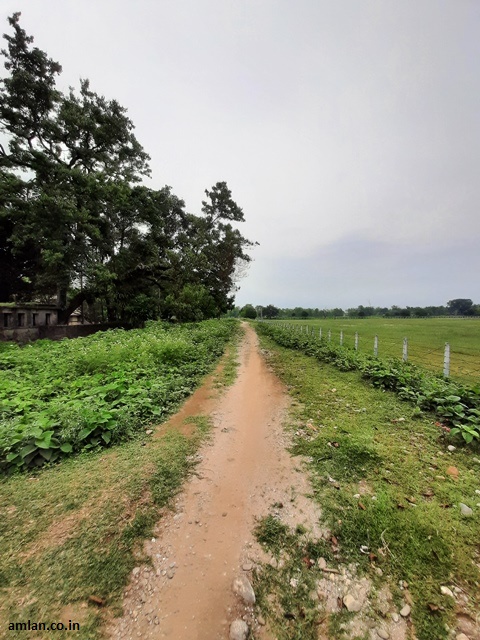
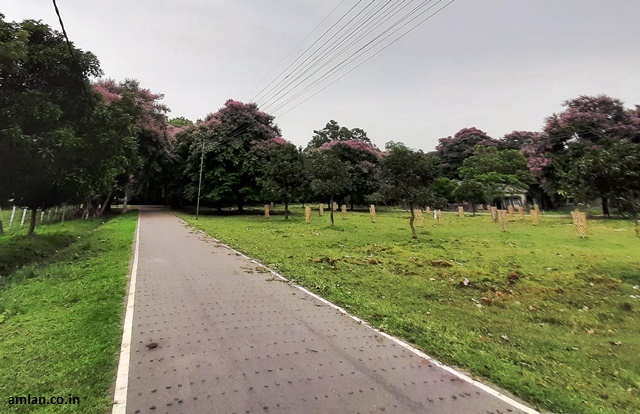
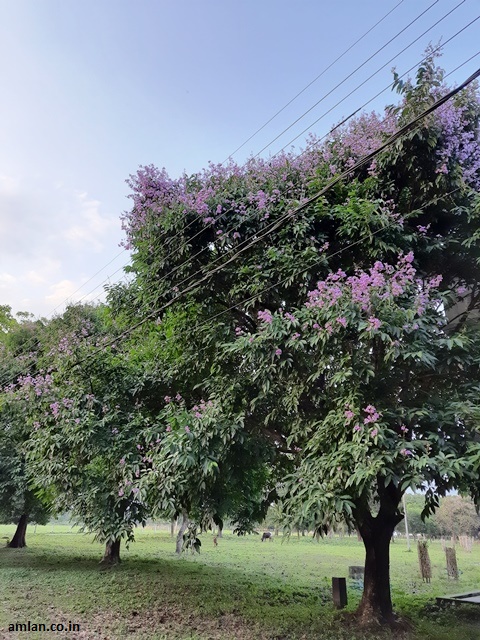
[Photography: Brinda Majumder]
The place is safe for comfortable living and superb for study and research. However as it is surrounded by bushes of trees and tea garden, one may experience some thrilling experiences at times – quite occasionally. For example, I have spotted (occasionally) some reptiles in the area. Often some news related to reptiles come in the local newspapers. Recently, one leopard was spotted in the area by one of our Colleagues while evening walk. It was a big news in several newspapers. Precautionary measures have also been taken by the University Authority subsequently. May be it is an unusual phenomenon – as wild animals are coming out to populated localities in different countries of the world due to the recent ongoing lockdown for tackling Covid 19. However, this thrilling experience of a roaming leopard nearby on campus is unique. It is heard that residents experienced such experience in past too.
I hope that you will enjoy my post on campus and campus life in the Himalayan Sector of the University of North Bengal from the perspective of a working teacher (and a common man) and encourage me to write again in future.
A tribute and honour to (Late) Prof. Manas Dasgupta
18 May 2020

A successful teacher, after completing nearly his full course of life with dedication in teaching, research, consultancy and popular writings, left one world for the other. He was suffering from physical ailments associated with ageing and else for quite some time. Earthly arrangements could not relieve his pain. He responded to the tune coming from the other world and moved consciously, where he will neither suffer from any pain nor will he pass away any more – “হেথা নাইকো মৃত্যু, নাইকো জরা”. Also, it is said that time and distance are void there. So, we are not going to miss him any more – he will remain in our memory and feeling forever. May his soul be at peace. Oum shanti … oum shanti … oum shanti.
I beg to be excused in advance that I do not have enough capacity to evaluate (Late) Prof. Masas Dasgupta (aka MDG) as a teacher or as a person. The only thing that I can share about him is my feelings. He was a very popular and friendly teacher among us at the University of North Bengal. He taught me during 1994-1995 in MA Part I & Part II. His lectures were too attractive to us. Simplicity in his presentation was unparalleled. He never exaggerated mathematical models in front of us. He used to teach us the facts not ‘text’. He treated all students equally and encouraged everybody without any discrimination. Definitely, he was a great teacher.
Still I remember some interactions and glimpses with him. I have interest in alternative systems of medicine for long. One day, in Part II class, he asked me to give some examples of it. I described the uses of turmeric in everyday use. He added some more points to my answer and praised me! On the day of my first convocation, on 14th December 1994, when I was roaming in costume in the Sal Kunja with my medal (which I received for my performance in the undergraduate level), he inspected everything carefully and advised me to preserve all these (including the costume) for days to come.
Personally, I have been motivated enough in empirical research on lives and economy of North Bengal from his path of work on the same. It is needless to say that he was the pioneer person to work with for the development of land and people of North Bengal and Sikkim. According to Sodhganga, a reservoir of Indian theses, MDG supervised 22 doctoral works of the Department of Economics, University of North Bengal. Of the 22, 15 are directly related to the economy of North Bengal; one considered the same of whole West Bengal; two are related to Sikkim, and one each is related to Tripura and Nepal. Two works are related to Indo-Soviet and Indo-Nepal trade issues. He authored several books and research articles. He has also been a regular columnist of Uttarbanga Sambad – a popular Bengali news daily in North Bengal. I used to read his popular writings with great interest. I hope that his tradition of teaching research will continuously be followed by many of us at North Bengal and beyond.
Last but not least, presently I am staying at the same residential unit on campus, where MDG spent most of his working life. I feel his existence every day in our surroundings. When I pass by the flowering trees at the front terrace or look at the grownup trees at the backyard, I realise that MDG might have planted those in his time with a long vision for future generations. In other words or in terminology of economics, his works are ‘sustainable’. I feel honored to be a student of such a great teacher. Although, I am surrounded by a melancholy feeling today for his departure from this physical world, it is a matter of great pride for me for being able to bid ‘a successful teacher’ farewell from my present position.
[Prof. Manas Dasgupta, Retired Professor, Department of Economics, University of North Bengal, Darjeeling passed away on 8th May 2020 at 9.30 pm IST as reported in the Uttarbanga Sambad, 09th May 2020, p.8]
A pdf version of the message is available below:
Presenting my old blog postings again
15 May 2020
This website was initially under the server of Yahoo! India Small Business, and then under the same of Abaco Small Business during 2010-2016. In the middle of December 2016, it was sifted to the server of Techno Developers Group, Siliguri powered by WordPress & Superbthemes.
As the site was transferred from one server to the other, all the pages were collapsed. I had to prepare the pages gradually with priority and importance. I had to drop some pages. Still some pages are not developed or designed. My “Blog” is such a page, which was in incomplete stage till recent past. I made it public today on 15 May 2020.
During 2010-2016, I wrote on many issues (all are not relevant now) in the “Blog”, which I would like add again. I observed that many of the issues (or else) were addressed subsequently by appropriate authorities. I will elaborate in detail in near future.
Having difficulty in copying and pasting below. Please allow me some more time to do that.
Pdf version of my old blog posts (2010-2016) is uploaded today on 10 March 2024. It is available here.
The first announcement
20 January 2010
https://amlan.co.in is published on the day of Saraswati Puja, 20 January 2010 at 05.00 PM IST.